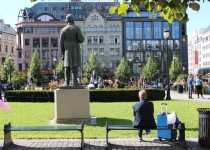Norway’s Political System Explained
Norway is a fascinating country, not only for its stunning natural beauty but also for its unique political system. This article will guide you through the intricacies of Norway’s government structure and how it functions.
Norway’s Government Structure
Norway is a constitutional monarchy, which means that while it has a monarch, the country also operates under a constitution that limits the powers of the monarch and outlines the structure of the government. The political system of Norway can be explained as a parliamentary democracy. This means that the Norwegian people elect representatives who then make decisions on their behalf.
The Leader of Norway
Although Norway is a monarchy, the monarch does not have a significant role in day-to-day politics. The leader of Norway is the Prime Minister, who is the head of government. The Prime Minister is appointed by the Monarch, but the appointment is a formality. In practice, the Prime Minister is the leader of the largest party or coalition in the Norwegian parliament, also known as the Storting.
How Does Norway’s Political System Work?
The Norwegian Parliament, or the Storting, is the supreme legislature of Norway. The Norwegian parliament is made up of 169 members from various political parties who are elected every four years. The Storting is responsible for passing laws, approving the national budget, and overseeing the work of the government.
Norway Democracy Ranking
Norway’s political system is highly regarded worldwide. In fact, according to many democracy indices, Norway frequently ranks among the top. The Norway democracy ranking is often praised for its high level of civil liberties, political participation, and governmental transparency.
Political Parties in Norway
There are several political parties in Norway, and the country has a multi-party system. This means that more than two parties have the potential to gain control of the government separately or in a coalition. The Labour Party and the Conservative Party are two of the most significant parties, but many others, like the Progress Party, the Centre Party, and the Socialist Left Party, also play a crucial role in Norway’s politics.
Norway’s Monarchy
Despite being a parliamentary democracy, Norway retains its monarchy. Norway’s monarchy is mostly symbolic, but it plays an essential role in maintaining national traditions and unity. The King of Norway’s duties are largely ceremonial, and he has no influence on the legislative or executive powers.
Norway’s Prime Minister
The Prime Minister of Norway is the head of government and is responsible for coordinating the work of the government. The Prime Minister represents the government both nationally and internationally, and his/her office is in the capital, Oslo.
Constitution of Norway
The Constitution of Norway, signed on 17th May 1814, is one of the oldest written constitutions still in existence. It declares Norway to be a constitutional monarchy and provides the framework for its political system, ensuring the separation of powers and protecting the rights and freedoms of its citizens.
To learn more about Norway’s political system, you can visit the official website of the Norwegian government.
- Norwegian Myths in Modern Media: From Literature to Video Games - August 20, 2024
- Urban Farming in Norway: Green Spaces in the Heart of the City - August 14, 2024
- Norwegian Legends: The Enigmatic Sea Serpent of Seljord - August 13, 2024


